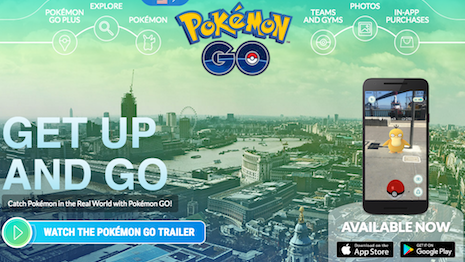By Mike Gamaroff
It seems augmented reality has at last recently celebrated its much anticipated bar mitzvah.
For years I have watched various attempts by tech companies and brands to insert “AR” into the public consciousness while at the same time I have struggled to hide my astonishment when holding a tablet in front of a bus shelter and seeing an ad burst into 3D life.
As a marketer, I view emerging tech through an advertising lens – placing myself in the shoes of brands that have a lot to gain from joining the jet-stream of a developing trend.
I first observed augmented reality on an iPhone 1 and I could tell advertisers were headed for years of experimentation along with an uncertain future.
Coin of the realm
Well, here it is. Pokémon Go. A perfect storm of technology, mobile adoption and a primal yearning to be outdoors.
It is a triumph – not just for augmented reality, or even mobile in general – but for people who are starting to realize that perhaps social media is not that social when you are conducting your relationships through contrived Instagram filters and status updates.
But there has also been some disappointing press for Nintendo recently when its skyrocketing valuation got a sudden haircut with the news it was struggling to define a clear monetization strategy. Who can blame the company? The app blew up in a matter of mere days.
Nintendo has pinned its hopes on “PokéCoins,” the in-application credits you can buy for a buck each that allow you to flick balls at elusive critters as they scurry by.
To be sure, they are selling, but not fast enough and not even close to the volume needed to justify the present valuation.
So Nintendo, in case you are listening, I have identified five other ways you can monetize this Objective-C equivalent of crack. My fee is 5 percent.
1. Place sponsorships
I was at a hotdog stand recently and observed a notice, crudely drawn with a Sharpie on the back of a cereal box: “PokéStop here! Come get your Pokéballs! Gotta catch em all!”
I did not make this one up. There is a rumor that brands are actually sending checks to Nintendo to manually create “lures” at their locations. But I would suggest creating a self-serve tool that allows brands to set up these lures and pay for them with a credit card – like Snapchat does with geofilters.
2. Coupons and incentives
So it is getting people into your venues. But what about when they are near your competitors?
This is the perfect opportunity to flick a ball at a Big Mac and get sent a coupon redeemable when you go there later.
Perhaps even better than free burgers is a complimentary PokéCoin or two. Trust me, people will love you if you help them get more Candy or a pinch more Stardust.
3. Passive notifications
A more traditional approach could be to place small alerts over points of interest with offers such as “20% off Ladies Shoes here.”
Any business that a player comes into contact with is a potential notification opportunity, even if it is not a PokéStop.
This is the ultimate point-of-sale strategy, given the retailer can be 100 percent certain that the consumer is not just near its store, but looking directly at it.
4. Virtual outdoor ads
This one is a little creative, but bear with me.
Picture peering through your magical window into the world of Pokémon Go, scouring for the coveted polygonal clusters on a real-world backdrop, and at the end of the street is towering billboard with a Nike logo screaming across it.
You lower the phone and squint into the distance, realizing that the billboard is not really there.
That, my friends, is next-level outdoor advertising. This creates a branded message that blends naturally into the landscape, instead of obnoxiously sliding over the scene as you would expect from a traditional mobile ad.
It is sort of like those ephemeral billboards you sometimes see behind home plate.
5. Augmented real-world ads
So No. 4 suggests adding digital billboards into a real scene, but how about offering advertisers a way to expand on their existing static real-world ads?
I am referring to the old technique of holding the device in front of a flat image that then bursts into life.
Consumer adoption of this method has been sluggish because people do not generally download applications just for a flittering single action. This is why QR codes never took off.
With Pokémon Go, adoption has already happened, and it would be a natural extension for people to take a break from their monster hunting to watch a BMW drive out of a billboard and onto the road ahead.
Brands would pay a hefty price for this level of engagement – much like they do for rich media online.
I AM NOT the most committed Pokémon Go! player, but I have enjoyed bearing witness to the convulsive disruption left in its wake.
The implications for human interaction, real-world participation and social engagement are second only to what is possible for brands wishing to bend it to their will.
I would just recommend that any brand messaging be contextual and integrated seamlessly into the experience or else it risks alienating an audience who is way more interested in building up combat points or temporarily hijacking a gym.
If people are paying attention, brands are paying. And Nintendo is making money.
 Mike Gamaroff is senior vice president of channel strategy at SITO Mobile
Mike Gamaroff is senior vice president of channel strategy at SITO Mobile
Mike Gamaroff is senior vice president of channel strategy at SITO Mobile, Jersey City, NJ. Reach him at [email protected].
{"ct":"x3Inv+g86eaoJt0qM38dLOPj72C+P\/0ZYS4vG4nscPPILj0He8MbVlsB0S9N\/zL5sjI1AoVh52BsK56LsY6bG6ATubN7peYKNEGFQjcKdlliAhwB6kr\/JY86xWmsLYVyjaAsWe8GvxeCNz8L9C4n+0lKzCNoo1UJjTx04kSgEm7PQ6Ohl\/l7DIGfJS9O\/r85KXcrO\/OY33pL8qdb5ebaCFmh7MCA5zDmlMSkTobFh\/phDVXznARFHVqbJTf2gOqWA0lGwpbVugUNF6ceRjjJU64xmB\/xwuQMd\/NmHFebYTXniN60Kcha3kB\/fHfPtNy7oW8HIwAuvssTgLaoC62Gu9w1o3esqZUA8ooTJv2rlu0SJaaFC1duBoxDOLVeWCRbMZ6FAU3FZVfKcGU\/2EyQ4sYaN7qQ2qy9k9tWxa5B0RHJA\/K5TiFIHRxFgglNJnVSL1k7tJCsJnmaN\/j0F2t9nUwQaI3neZVnE59U59DVTT7pFudvs7L0tMw\/EmcgToa9oWOVuNzLRscSACJ1PdFEgrfaiBBjW8To6ljmsax9ZzFzLOuHk9+DT8GBLqqTxN+LhddW0NLvFFU1QsVdCANAVq\/o7Qb9bcpz0VmMSW16gyPJOIdLuPtrbnQO1V+gL6XhpNBKcNWJ8PJFieexFW2NrswMZFrRzXLsWFKCzKHM2HphHDt3RLi8lNYXab6cGI+RD5iI7oYjFdkyI8Itpo+gTVdNTgZOyorwBKO9vpyt2c8ayJ2padftCXiV94a9lcLG6Sa10L9CBdAwQIURYLi90nGbwzkKbHBqSNbZo0oqaZA1QVP8rawU\/FXhUMQ3FKz1X\/WtgOUuXKf2Ds2uCn3gkgMTQYbbJION4ILNrsgMs+PuvEL\/U6uWQZ2GpSQa3n\/KoK14VyBVaOvyHvZZCkwYW5HbzHdrFOGmXbhytxTXkpsgoeLmYMwaXz04CL9UyaieED0XLPAM6B3ll8h0rybmKi856MVxjTCo8v30a2ntKZCkKkUH7h8cXPY0DAcGEDA+pXNBXzOAyaCM8c3+dNStOJ\/aC285LH7HqGRF8NsMhXbTXHJp3huvxBvwonl8nXubBNUzju\/a8mAavgle\/4t0Syeex9J421zXN0PcJEzSsoZe3453unOy8AFAjE+bjHTUKogRtc6ZvqR7Nnxv5HUgKy7Nt3MmQNzISLtbRrhImLapJlPd9B1wNE8dJAJ\/oe\/2rn3cnxJCKGBmkGXzOV+74K8r4WC2rzW0NEKAfi8EcmuVU\/FdcvaE9waoQZfKDuQ1b\/RxT7Bc8yFTmfjxAMC7gMiu9eLRFC\/+NN6EYGVr5iWW91HXLzFd+RZ7\/uVlnM3pjGgvpjjgDsSyatpld22o1BPpt8KvlDTHXMYYZ8tJS+gjiVpDRdtz6p\/FxFAvSJkBCUgj1NU6jC14S6UWLDrZFxfWVQ7uOrThFJAkyaKWUcrg\/m++\/YHTe\/1RGGbpB6G6dHxUndma6fi8dI\/evLJcSZq\/dsuIB91b1p2cm7syqLFjHJ3wJn+2b9ZC07HvfD00LebT\/i1FAGabYO8YXhgkcRZTBPadQ67o8lVBhgHeCAl6QWao1HytVa2ssBF1pe2TWxA2pL5q0bbuY\/bjJnkpARVIMEWdIcr+lwCyon\/qAmqcjIO07CrFfwBdGrOggZ9RD5O3vvrznlYkgn01yvqSX9SssrvbD3zd3ZRbGMFAeG0q6CUK+pp2xOHK9LUX1kniVf0J8i5ucKT2QwaFROGEOKsUfiqIjVhybjMQ5K3LZ2d3NvU1nA8R1lG6l\/X2tFXQdmYhLm6KFHUlERaea7A6MTtYCKK6lAIcJArOE0MM9Wj4ikH4AosEkwn7hb3W+in2HCqDYHDy+QaiyHMm2V1jCS7KTQfjt8ppkUWuIDpaCNwtjgzUMRU0adKDIcfjhkAvfp0TqUcZsLesrZKe00oVHDVfNVm+7Rxlwft8kRe3f20ez5NlZcIquXBw5kZlOmqUBPF5oA8ckwt2DGnMAZYjJfcWy47RET264qINRglY2GASPPvQLredu6cACdHoloG0VqroSuPeoSnu\/hUrGbC4mcyA2xKSsczmfXc04qGC4X697s5I4c+f8xiFKpi5E+D2pR3jIUmcnrhFKy79SMhBzlqHQCYeBmMgNr0cO08hXNExmYqjoPpgeLI2nA+Hd3b6sFvvl6xL\/LNmdKptaxA32PcBlY3cD85ns3Ep3XuuzzkTr2VoEc8J1geEdQWHQLWFyW2pkyK9IHqQPWBPrxDajZ0uazheG3yCVLXen5KtfC9eexuwJsskpNndVNj89sDhILmjqhvHyPwZheDiVI572+zTPHxRpnLp34h\/aBVCYZX5fnDp0o+8XaEah81EGY9LAX0D5\/jfAGCwOYdOJwp3Jdtl\/N90yZ6yIvThRSmKmwuNjL49tCYATgP93TrlCKbLWRe3wjAYVfMynYI9IlhRVNvP+L\/HDk13CCsSXcvhLsK1uhU9MkrzSaOzNJ\/Yv3Sk5UFF\/S33vakM6Wf5V6IYnhkYxgRF6CkmQaXAhUEbF4Beae2V1k5gKjOAyD2t392VsiSb\/wkv5h+8q6dfEmC7jW6gUBeS4LOY+lvyj7uKA+fvuxWb\/nbiC1Y6Os1kCPyFeOtHgYGFOtBzKtM\/ggX9INoDDMZ9marLE5+0yJVAwQaFjxlQjE0SaOX4ByTl+3rJKGkqAZw1vx99doJ\/IQGRE6lut91uTbaNPetXD1oapniDHWOSRK13DBsL4QnhelNjEzgS2XPFPDqgFV6fDTvocJ1\/mfyT+AmGAw0n9NGnJZL0vCwKzkYtBLS7ajYeX4\/IkNfo7MukelC6z1ucArTHhWU4YwKwoD\/N1U06nIvX9eNaRb3krnyxDXU0M85VAjQtSObysYMMgXaVPAblNLP\/utgn9zbA4cBsfYL5PeEKfciw2V11kZSkWBYGaf8PvUOxR\/SDv7MY5Nl9tKrAqIncsWutzDSGV\/miI+mfZ57wDYqYtTV9fL8zdOX7Gybv3xGUM7iKW\/ps+smSBzuiQK\/l4L6dRHG8MQqfUmjt9NYKjGOAfa4T0vCuD9CQc1L1zux5\/SYLjloWoe+Hi917DGluxUte\/0WhhJbDMPkRJzs0yQHSPSLnABSojzwADRpjEnOZlfP4Bl5omJdzIButFNwgVi\/kdbpuJZZx7DcgER5kOGuqtFJUpidd8kpjJUtbTTxjeZg2kCxyRk33ed+RMyw53u15Zt3YXjTtp1zVnpSEqe7vbQrlnzqMA+AGTeC8nbjq4zd2MdM+xq5cBQEAJNQnBx03NNB\/JnVBGUxezXmlHeJXzc15OMqs9XPni4RYPp1APPxHqK6bBig4SxglL+kPTlZlIn3kCe36pYbDi0i1e22Zoq\/bOcF1Xra6YIZO6JuZCWTjgcYD\/CMxHBG3\/77B8R\/Dr5giBLYFgi9A7TXUfAD3rZiAuc+Tv\/SJwe0j8nNwiOJkDigLMi717TaI60l3FJzSF5C5VUmEvHJqSldBavegF2aa3cydNyPhjn5gPrHWO9rS+A8Uwuy3NHYVW9Fb1e1ZHhVvfEvQYPU60yeYrEl1m3hNqkFDSRKcLcd7iV5Z+S\/kp4F4G+KGMyFO98MVYHdRKnOp9qFBKBtnN2s62RaWOAq4D2+shNO5GdRWPE\/4jiP12gVaUH08\/3xn2i2k16a7fosuzfFfgAVM9nU2lkzK7QxH5h7wNL+4FRvv1qWnTPUgn0PLOBBQA4Oic5luKwx43KsicOwOaRdXl5vrjK5lntyD7ozFJFhZiKndtffYyrSANYRaCEEFcvT4XfgFvE8xZM3RTpTcdxAldgxRdQl25NN5KxT+bqceOFXHiUudD7Rc2IVpLkAtWhD6MzaSrsmqxahaPmyWc0xfPridwMQm672zQFFhuq2dIlMizBHikqLNqgXmPNiIhyQgAEHQp+Wx5by0EWVJmUGazuTTilJAn9hafhEWsRDCdk3FRn874Ojx5BQ7UXPHOLD1ezmf3nB\/GqRhv0YIgAiChjV6vgmGpBZMf\/IO+wr5XDKnfTTa0gqogGY65O6CrcK7YCUpeHVpOrDJv8vQ52M99Gzul\/55Bf1yf0GI1O9WNNjvK5LD634Z+d3pwMlre00JJgBvCjkx\/Y0aqGZC8HQBJOUiIrxfCOs8IuTNzQnBq6DxDy6iJ+dLPR+z4I+K33X+9FVaWBwQzEjCHQ0d9knFk3024AXaKADSM0N8xVR+foN6yqc0r6Sc8j+f8JSOqtHEm8MHXS\/tJD1GhSAakeTjLoshnwABhQ\/RzEb\/D51jIYHhNSz1IehBGf6GxYONfgG05b2kQrvjA\/Gjtxrkmz3bevgS9zOn9QFTPd2i7Cw+oLjTALs6WQ8dxSWu5E+TnKDfzEd93spEZ\/rUuQIbeXng\/xxVGDLGG2muNLLMHvRMuDWi34N7k6rPQ7Erz58t8lFIm4RFgJQMBFYdB22LXzaFFf++5H2D8Hruk7Ik3pUsxv0JsMQYYaPFxRPLrnbuSm4r+i6BiOwgqM8qX8OMDoPY9VNtoUJnnA+OXdNznqkFjyfoekppCjrrGOMBbKd3fw\/7jhaxRIjAu8CJSoiFfZa\/hYa0yhq+C1BQYiYAGsAkoVgp8PAt3VleatOZ8bXfXNJ6oSLpj1Ss5wi6qzuG74uQGZh1Wiv3HAK0IP2FOsSZo9VN9bz7RevcfMKyMImfEHVk74YzH7z4FRy0Lnii0RXFVw73yY3DcePMAk4AYoeXsRyrx2K2OYIa7d8DKDdr9La3s2VjFKxm6\/tvrLjaIuW1Wr1eLZiuhQ9aGons0vYloBKZCnt1JnBbVF8vOOtP++JQBBndVviceVjBELdQ1AlcYhkSVfZH4IZoR543xzXKvjRHhMnqKvbLpBgFDW5yESz34mYL0emv3I3lPgdk6cxuJkSinlIXXl9toprc+1D5gr43+FpFy2HkSVfdMBl4qtaVVl11cCXs\/MD4Ow59LA663xPH7JKGWKVAtlSzcuY8uhVkpYKQcydmICbWqdLhdUvOv53Kono6uiUD123Hq7rfdC8WfzXKuEWII9L\/pNnW+6C8QRUYhO+xLqCIR\/BEmTh5nvfd0Nvcc1HPenNMEvTJ5jHOvjBcnZsHWwgXzMGt7DFCx9J9QGQVtxM9dt9S2jSquEz6PR975LHet0JtOHaQqXwZpnzxDHklPH+03FvAizWeSBE\/7nyu\/PxAQ6e0JOMYcMAzfDC1dO3WyVxYpKtjeHJy2NXcwEtew+4WjBESz2zLnIoV\/o83lf\/sPYklvaNr50RoF3aA2jJOQVUGtlKXcNyWi3sHEDiBXbaJh6dYe1agmQh4GqwbQ4FKLB0\/ek4\/l7YkbSPZX9j9a2+KrJc6fMPYBjQqlKxR7FqMKvT2XoXU1tLHUFbN4xPCFnKZhIJj4KJdSfGeUJWEHPxcVtKKaFrbhbJFb6NV5pQzuwTH01RggTtNmBG5JDNCvIJeRW3bfZT1c8BnZ\/R4nFD0Kr9SXmtPeeFgd9KG4BsBrG1BoZqP\/SUIOaE7eDpeocbDNOqErsJbr7A\/jkVvvNaTwUXS4j57EOMZ21LtDJE36PcJ1wPv0wB5no4W17krTHhVaP+\/BhFisDP1ugmeUPTJfc8wHnFuK2MTKqEmjqs+jlMbEXc6\/PnPIrMXXnnT6pB9WTTqMxkPjRlh9p\/WM7IlEn7Uevz2rD93kMB5CnS6iS\/um3yCJkr9kQj0kdKXv5k3LEaLmmW08CCGSiqHxrh0sJtHbPuKxnw6r8A9c4850db5KBwrAK0PUZvPbzuPEjseVGyd0z+LPiRHUpMEt\/ozu1tqGuogj6R\/arZachM8NYQngoI6YWVUHVFPl4TpSdbD9dgRILxGap5wqNft5BUltXOeqabFqf7W1e+wDTM3QU3xLure1QvxAdyhHtbDxBOAq4mG1GCThUzGqZf4mmhsmyyCBGkTaVkgHRvxiAjvSoiuJXg2atADmyz+tdFAKh0wtunnTAjuqHs8XISCGpCE8uf24RdNEPU4jcoxPC361H+u9HAZhmJFMbDrItx5mZqTjHtB4KSd2ksWZhSBhMWl+vcewtL9oFzOEn\/4t4a0N6CJMPrxeGAs8PeErW\/9ibsDt0wJLkdDlAvVsCc0AKor1Ku3uLt+MdFRADBJgVjjNJo7d1mpTUW7hicExwGQUec12Owv9odh2zZ7sXm7FCvqdPYRwiskkCcmwRRutKbr0YI8jce\/NGh9unkac27oBY4DTGUgDTCLEooHfaYbNQzb0dVXRJPGqlNxGgpCycxYE9y\/OZ8QHA8xY1194LVPB0NtF2Du3\/0l+tmIYNFTrKTA2RODCuhKcOF7P7RzKEGpVyF\/rrSlOzqYqWM7Xxpj\/GSwKIYz9vRaHCXBpqLWEewwhZZ6sXWVOOt4Bb42sWTkNBLZsDBUm8HQ6e\/tzIL6Ferk5R6Xmwe8KWWU2Fyqw+S0aWiqJMPYhE1k95nBLuQVSS6pNmtBZVCWYBPhe3ghQwcadGbn4nvGT07jjknp9ptDBTL1uRNKuYkPxGCKl+bVlybHOkM6W+y3JKRGaAj7NrHcTHehGXUHGqwqinIfHMdEIc5\/CA\/p9XQE973ZHvxleNFUdeDIxuu9gMzq+sS42dTZ7LegEWvR9LDqimg2ibedvnSBUzNdeN4OFIvggXZuffUHKTeRyMRV5lYSt0An784wuuTNe6faXdnRNd0se6BDb3oimZ9yh7yrJdq2j4ZpstV\/rCplkkXBnwrkb+nDhUUajyvubRMwjR6Us9gEUoSjul2lvj49aeiOj8sbqXF\/AbjteFNv2RENJQWEH\/s6O22NStHDHgkpKgOy\/\/C5WqA+1dlRPwa+pkba8zdnKSIwDCRiEqRzLrfz6cg6BjKzFclBcUfeC2+ZTHW2lcVudvbLqsSv\/NcBJJhmioERA1vAN9aWR\/mBkGLSpDjZukDehPZ1wu+fyX\/4+GIAoYiydDS\/gVJq2CTLAgepyGVOizIm0As1r\/HIM1hINxGjnZ6+9NOP77xlB2NquM7nZns\/PCAQq5RpaVFKu5Bqg8DPf75dxcevBSmDQAgMLCP6HZt7t5IeQmh\/WdeK3NglxaR2pAY8C8ZkyUI3xHGjQHtubANAO79hNIH3L\/YYWmtrkdwRc3TQVpePlRaRe\/7jQJHJn3fChNovhWOb\/\/iubX\/GkzTh0EMY\/nk2FXKjN5+dauSpsRtIrnekfrswTSs7tpym9FQA0E5RpShTcPtnu8DGW74hdGquy4cTBwG\/BmAwWlJ1T4P4lIos3MTNKgQ4+mTZZDA1\/vH75RkrN4eH9t7UZqtcTlhZ7tmjR7SW8AGNSVv2lG+q2ubNCdAX9AWi+QOvhZZkSC6t2TPmf0FVidy7srtEzbwLzHYgFYZROOmZcaLmBkGpTvataeZNJz8\/fdPoy0KIut+47wARGpZQC7uct6EfF+QmLOD6XOlOdEko1h5D9MM4PPvNDjZ\/hiWgiTXEMxS8xqk8AjXaYmaZwYSWCUpTR3\/1xA48cO+fXh+DEFdx9yantnUDJL18Pm+sg4LYVxGIOegXa8QRsx6ovK0y7iJfju06yrapQeK6J0Gxftn0WUmsPXpvoWepN62qeqFdpLWfkgQJvjHrsTDd\/WmaHMstQauC3Mv7LtWMCjIyOpZpdkYvjWKlNcqMajUxEq9HJirFOSlqIKI22uP\/9X25EUd\/EOZ0+xrOIuqt7AY5Ammzcmj9\/jerAkEr87uBjg1Vi+kcilmRet24eenBnDsuyJWk8j1WZE9mtlh5n0MpjA\/zfgd8oMPejRdb798Dd+yuAsVU7YXawQfJOacrhDYtfHBM8HURiqx5LODDvGw2C6U5vKB9SMeJ2L\/wafwh9dyyr4TDed5TbFTU44Nk1i7cWhirRfeY1FKPlNZrPaOP1bsKKMAINo3E67Yz1ZTlmnaFi3jVQQ4kzplHpqmXOI9hDmn8PpNxDKqhnsr3o6NYOkrn5bkCKggNYzawMe9rnn4G2dWCkNlWW1MFaPHV4n8dDTQES9yqMhberfwNQZ62k8BAVtfx6T3VUS6oHryjObf0NPE\/NGQ8q9Q1fKIq4C803SBo3HK+RMQNRu\/4YehDdFdy8GeX6sXqRQU3\/2+LTLjIAH69mr+cOrqILIIwJYj\/1Hbc\/p677sza9PYTyC0jJ\/0bbeUKj0Xw+tIyqKZNM578NYI9O3kxTgUcMVU9faeidA2QO9Er+vMNBeIY+wsbW\/e1MutPGDVz31Pt3j2PX9+t2RlWGbAuQPGAOapTJgNf068AFbKoyHHExATM+kHRY68Js4OWT1p9Ukpz8M27nrTsLvbFy5Pz0XDsUrLYOuQhu7pPT\/vLhrL9I7HYP98SDAANrhWRlu\/uWXEVmaSkw2K087FiiD4esuoojtR\/cOhcH0vaJ2a7gpFlOiigVGBc2ryWHQvg2zBGm\/XO1stEXasqGycz1EJA+wzJ6Rzz6urCWDHvLrVNGHbRunl+59f3PfWJqo1UgU0cjb+cF0v\/wGfm\/fSO4g7ra2xDAaG3QRHiy4I8Aw52GJz\/B7\/TllppsVxD62wNcff1SeQpkLLB99l9ZQTI124z4b\/3V1MTwy4x4Vw\/F3Y1n3AKD4gAt+zKBTdt+3mJBmB4x67xgKb0iijw2PNUqmUYD+5Tczw9qm8cPKdvHu0PNqkrUnCVZ5jvgxgg3LuxRxv3goQ38HvdnZhcTzdaoRrGsymQRdPykmN2aeZZmwT+wMondaSvIXS\/curTsaInzNuAtNmvlaZSpll0b5lWP7oNWBm6gw\/zFU0VX5SARKtC8s2PBfdUq4I8rZh\/c7SyqRd5rC7K0rCzoACOT1ZxEJ3zsbgjWd\/moHli37a\/KNV8Ec6wgKLztAEdT243ram\/yoq5Q3f\/gUT2Fv2s69DJcpBV3VfRfEH3VB+eNPWEY6m\/A28Yk0NwN2xtyKbb+m3qLV2qzoWn+nQvecNPbUUNHKtFkfLpKqI=","iv":"ef4d23ca25eb054424364db0c2fcf54c","s":"4ceb5340ab904102"}

 Advertisers should get real
Advertisers should get real
 Mike Gamaroff is senior vice president of channel strategy at SITO Mobile
Mike Gamaroff is senior vice president of channel strategy at SITO Mobile